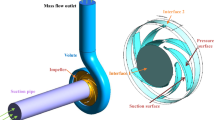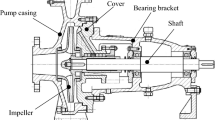Abstract
Cavitation behavior is very important in pumps for long time operation. However, there is difficulty in predicting the cavitation phenomena of pumps by Computational fluid dynamics (CFD). In order to accurately ascertain cavitation behavior, a comparison between CFD and experimental data is a significant and essential process. The purpose of this study is to analyze cavitating behavior in multistage centrifugal pumps numerically and experimentally. For this investigation an experimental set up was used to obtain cavitation performance results. The CFD method was used to investigate the multistage centrifugal pump performance under developed cavitating conditions. The Reynolds-averaged Navier-Stokes (RANS) equations were discretized by the finite volume method. The two-equation SST turbulence model was adopted to account for turbulent flows. Numerical data were validated with experimental data and a good comparison of results was achieved. Numerically, cavitation performances were obtained for different pump stages and the effects on cavitation were described according to different NPSH (Net positive suction head). The occurrence of cavitation was also described according to NPSH3% in the head drop lines and water vapor volume fraction on the impeller blade. The rapid drop in head at low NPSH was captured for different flow conditions. It was found that for stage to stage performance, the head drop changes could be related to losses inside the pump. It was also shown that the simulation results can truly represent the development of the attached sheet cavitation in the impeller.
Similar content being viewed by others
References
B. Schiavello and F. C. Visser, Pump cavitation—various NPSHR criteria, NPSHA margins, and impeller life expectancy, Proc. of the 25th International Pump Users Symposium, Turbomachinery Laboratory, Texas A&M University, College Station, TX (2009) 113–144.
Japan Association of Agriculture Engineering Enterprises, Pumping station engineering hand book, Tokyo (1991) 50–90.
C. E. Brennen, Hydrodynamics of pump, Oxford University Press, Oxford, UK (1994).
B. R. Shin et al., Application of preconditioning method to gas-liquid two-phase flow computations, ASME J. of Fluids Eng., 126 (2004) 605–612.
B. Pouffary, R. F. Patella, J. L. Reboud and P. L. Lambert, Numerical simulation of 3D cavitating flows analysis of cavitation head drop in turbomachinery, ASME J. of Fluids Eng., 130 (2008) 301–310.
D. O. Coutier, P. R. Fortes and J. L. Reboud, Evaluation of the turbulence model influence on the numerical simulations of unsteady cavitation, ASME J. of Fluids Eng., 125 (2003) 38–45.
I. Senocak and W. Shyy, Numerical simulation of turbulent flows with sheet cavitation, Int. Symposium on Cavitation, A7 (2001) 2–8.
M. P. Fard and E. Roohi, Transient simulations of cavitating flows using a modified Volume of fluid (VOF) technique, Int. J. of Computational Fluid Dynamics, 22 (2008) 97–114.
D. O. Coutier, P. R. Fortes, J. Reboud, M. Hofmann and B. Stoffel, Experimental and numerical studies in a centrifugal pump with two-dimensional curved blades in cavitating condition, ASME J. of Fluids Eng., 125 (2003) 970–978.
B. R. Shin, A high resolution numerical scheme for a high speed gas-liquid two-phase flow, Journal of Mechanical Science and Technology, 25 (5) (2011) 1373–1379.
V. H. Arakeri and A. J. Acosta, Viscous effects in the inception of cavitation on axisymmetric bodies, ASME J. Fluids Eng., 95 (1973) 519–528.
F. Bakir, R. Rey, A. G. Gerber, T. Belamri and B. Hutchinson, Numerical and experimental investigations of the cavitating behavior of an inducer, Int. J. of Rotating Machinery, 10 (2004) 15–25.
R. B. Medvitz et al., Performance analysis of cavitating flow in centrifugal pumps using multiphase CFD, ASME J. of Fluids Eng., 124 (2) (2002) 377–383.
D. H. Kim, W. G. Park and C. M. Jung, Numerical simulation of cavitating flow past axisymmetric body, Int. J. of Naval Architect Ocean Engineering, 4 (3) (2012) 256–266.
X. M. Guo, L. Zhu, Z. C. Zhu, B. L. Cui and Y. Li, Numerical and experimental investigations on the cavitation characteristics of a high-speed centrifugal pump with a splitter-blade inducer, Journal of Mechanical Science and Technology, 29 (1) (2015) 259–267.
D. Croba and J. L. Kueny, Numerical calculation of 2D, Unsteady flow in centrifugal pumps: Impeller and volute interaction, Int. J. for Numerical Methods in Fluids, 22 (1996) 467–481.
Y. K. P. Shum, C. S. Tan and N. A. Cumpsty, Impellerdiffuser interaction is a centrifugal compressor, Journal of Turbomachinery, 122 (4) (2000) 777–786.
A. Akhras, M. El Hajem, J.-Y. Champagne and R. Morel, The flow rate influence on the interaction of a radial pump impeller and the diffuser, Int. J. of Rotating Machinery, 10 (4) (2004) 309–317.
A. K. Singhal, M. M. Atavale, H. Li and Y. Jiang, Mathematical basis and validation of the full cavitation model, ASME J. of Fluids Engineering, 124 (3) (2002) 617–624.
R. F. Kunz et al., A preconditioned Navier-Stokes method for two phase flows with application to cavitation prediction, Computers and Fluids, 29 (8) (2000) 849–875.
I. Senocak and W. Shyy, A pressure based method for turbulent cavitating flow components, Journal of Computational Physics, 179 (2) (2002) 363–383.
ISO 5198: 1987 (E), Centrifugal, mixed flow and axial pumps-code for hydraulic performance tests-precision class, International Standard.
C. E. Brennen, Cavitation and bubble dynamics, Oxford University Press, UK (1995).
Ansys Inc., ANSYS-CFX (CFX introduction, CFX reference guide, CFX tutorials, CFX-pre user's guide, CFX-solver manager user's guide, theory guide), release 14.5, USA (2013).
N. J. Georgiadis, D. A. Yoder and W. B. Engblorn, Evaluation of modified two-equation turbulence models for jet flow predictions, AIAA Journal, 44 (12) (2006) 3107-3114.
J. F. Gulich, Centrifugal pump, 3rd Edition, Springer, London (2014).
Author information
Authors and Affiliations
Corresponding author
Additional information
This paper was presented at the ICCHM2T2017, Sejong Hotel, Seoul, Korea, May 28–June 1, 2017. Recommended by Guest Editor Heuy Dong Kim.
Md Rakibuzzaman is a Researcher at Soongsil University, Seoul, Korea. He is currently a Ph.D. student at Soongsil University under the supervision of Prof. Dr. -Ing. Sang-Ho Suh. His research interests include cavitation phenomena in turbo machinery and biomedical engineering.
Kyungwuk Kim is a Researcher at Soongsil University, Seoul, Korea. He is currently a Ph.D. student at Soongsil University under the supervision of Prof. Dr. -Ing. Sang-Ho Suh. His research interests include development of turbo machinery.
Sang-Ho Suh is a Professor of Dept. of Mechanical Engineering at Soongsil University, Seoul, Korea. He received his Ph.D. degree from Stuttgart University in 1989. He has been teaching at Soongsil University since 1990. His research contributions were in the field of fluid machinery and Biofluid engineering. He is currently working on biomedical engineering research includes biofluid circulations (blood, urine and air flows in arteries, ureter, upper airway), development of biomedical devices, and industrial application researches of performance evaluation of pumps and hydraulic turbines, development of automatic waste collecting system, Pneumatic capsule pipeline (PCP).
Rights and permissions
About this article
Cite this article
Rakibuzzaman, M., Kim, K. & Suh, SH. Numerical and experimental investigation of cavitation flows in a multistage centrifugal pump. J Mech Sci Technol 32, 1071–1078 (2018). https://doi.org/10.1007/s12206-018-0209-6
Received:
Revised:
Accepted:
Published:
Issue Date:
DOI: https://doi.org/10.1007/s12206-018-0209-6




